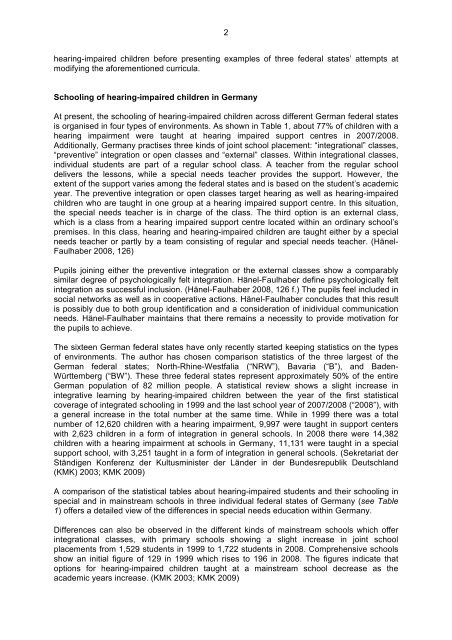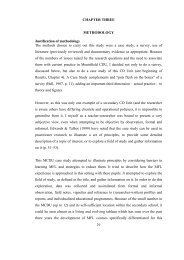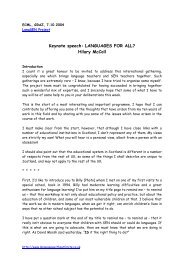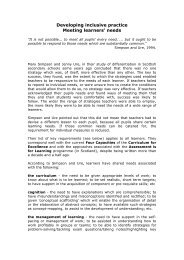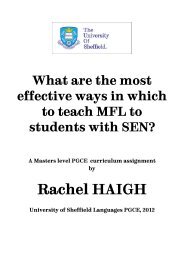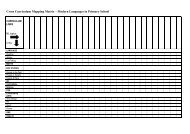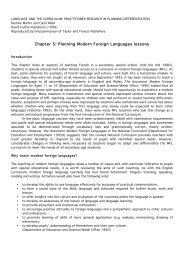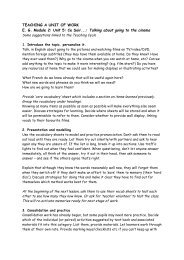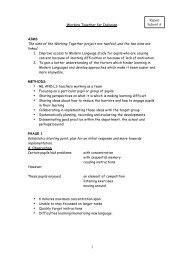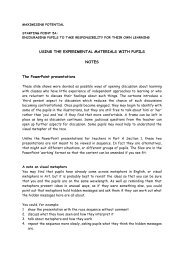The early learning of English as a foreign language by hearing ...
The early learning of English as a foreign language by hearing ...
The early learning of English as a foreign language by hearing ...
You also want an ePaper? Increase the reach of your titles
YUMPU automatically turns print PDFs into web optimized ePapers that Google loves.
2<strong>hearing</strong>-impaired children before presenting examples <strong>of</strong> three federal states’ attempts atmodifying the aforementioned curricula.Schooling <strong>of</strong> <strong>hearing</strong>-impaired children in GermanyAt present, the schooling <strong>of</strong> <strong>hearing</strong>-impaired children across different German federal statesis organised in four types <strong>of</strong> environments. As shown in Table 1, about 77% <strong>of</strong> children with a<strong>hearing</strong> impairment were taught at <strong>hearing</strong> impaired support centres in 2007/2008.Additionally, Germany practises three kinds <strong>of</strong> joint school placement: “integrational” cl<strong>as</strong>ses,“preventive” integration or open cl<strong>as</strong>ses and “external” cl<strong>as</strong>ses. Within integrational cl<strong>as</strong>ses,individual students are part <strong>of</strong> a regular school cl<strong>as</strong>s. A teacher from the regular schooldelivers the lessons, while a special needs teacher provides the support. However, theextent <strong>of</strong> the support varies among the federal states and is b<strong>as</strong>ed on the student’s academicyear. <strong>The</strong> preventive integration or open cl<strong>as</strong>ses target <strong>hearing</strong> <strong>as</strong> well <strong>as</strong> <strong>hearing</strong>-impairedchildren who are taught in one group at a <strong>hearing</strong> impaired support centre. In this situation,the special needs teacher is in charge <strong>of</strong> the cl<strong>as</strong>s. <strong>The</strong> third option is an external cl<strong>as</strong>s,which is a cl<strong>as</strong>s from a <strong>hearing</strong> impaired support centre located within an ordinary school’spremises. In this cl<strong>as</strong>s, <strong>hearing</strong> and <strong>hearing</strong>-impaired children are taught either <strong>by</strong> a specialneeds teacher or partly <strong>by</strong> a team consisting <strong>of</strong> regular and special needs teacher. (Hänel-Faulhaber 2008, 126)Pupils joining either the preventive integration or the external cl<strong>as</strong>ses show a comparablysimilar degree <strong>of</strong> psychologically felt integration. Hänel-Faulhaber define psychologically feltintegration <strong>as</strong> successful inclusion. (Hänel-Faulhaber 2008, 126 f.) <strong>The</strong> pupils feel included insocial networks <strong>as</strong> well <strong>as</strong> in cooperative actions. Hänel-Faulhaber concludes that this resultis possibly due to both group identification and a consideration <strong>of</strong> inidividual communicationneeds. Hänel-Faulhaber maintains that there remains a necessity to provide motivation forthe pupils to achieve.<strong>The</strong> sixteen German federal states have only recently started keeping statistics on the types<strong>of</strong> environments. <strong>The</strong> author h<strong>as</strong> chosen comparison statistics <strong>of</strong> the three largest <strong>of</strong> theGerman federal states; North-Rhine-Westfalia (“NRW”), Bavaria (“B”), and Baden-Württemberg (“BW”). <strong>The</strong>se three federal states represent approximately 50% <strong>of</strong> the entireGerman population <strong>of</strong> 82 million people. A statistical review shows a slight incre<strong>as</strong>e inintegrative <strong>learning</strong> <strong>by</strong> <strong>hearing</strong>-impaired children between the year <strong>of</strong> the first statisticalcoverage <strong>of</strong> integrated schooling in 1999 and the l<strong>as</strong>t school year <strong>of</strong> 2007/2008 (“2008”), witha general incre<strong>as</strong>e in the total number at the same time. While in 1999 there w<strong>as</strong> a totalnumber <strong>of</strong> 12,620 children with a <strong>hearing</strong> impairment, 9,997 were taught in support centerswith 2,623 children in a form <strong>of</strong> integration in general schools. In 2008 there were 14,382children with a <strong>hearing</strong> impairment at schools in Germany, 11,131 were taught in a specialsupport school, with 3,251 taught in a form <strong>of</strong> integration in general schools. (Sekretariat derStändigen Konferenz der Kultusminister der Länder in der Bundesrepublik Deutschland(KMK) 2003; KMK 2009)A comparison <strong>of</strong> the statistical tables about <strong>hearing</strong>-impaired students and their schooling inspecial and in mainstream schools in three individual federal states <strong>of</strong> Germany (see Table1) <strong>of</strong>fers a detailed view <strong>of</strong> the differences in special needs education within Germany.Differences can also be observed in the different kinds <strong>of</strong> mainstream schools which <strong>of</strong>ferintegrational cl<strong>as</strong>ses, with primary schools showing a slight incre<strong>as</strong>e in joint schoolplacements from 1,529 students in 1999 to 1,722 students in 2008. Comprehensive schoolsshow an initial figure <strong>of</strong> 129 in 1999 which rises to 196 in 2008. <strong>The</strong> figures indicate thatoptions for <strong>hearing</strong>-impaired children taught at a mainstream school decre<strong>as</strong>e <strong>as</strong> theacademic years incre<strong>as</strong>e. (KMK 2003; KMK 2009)


